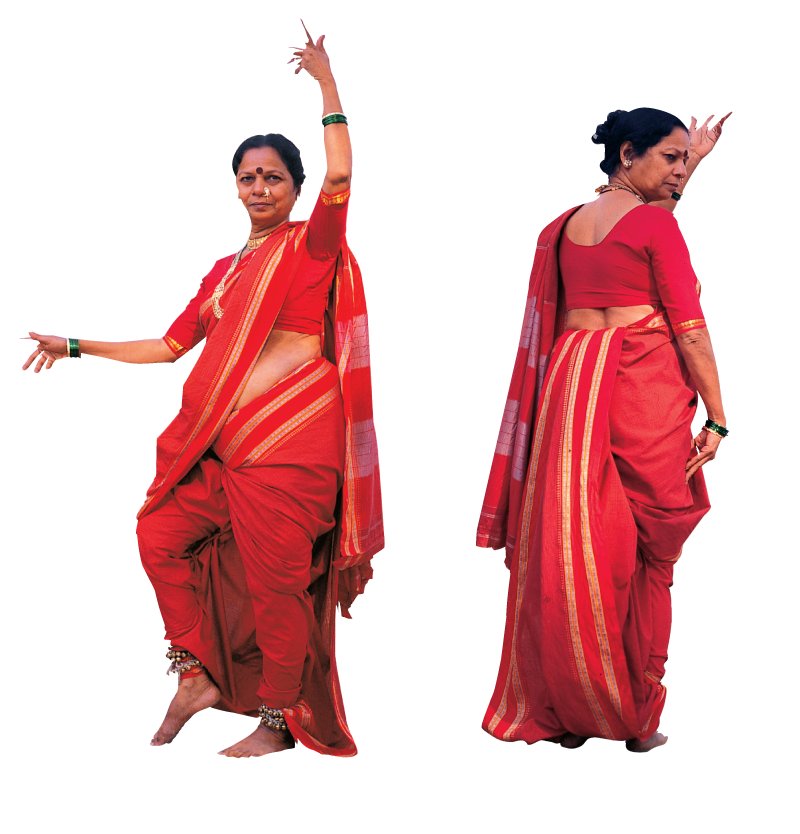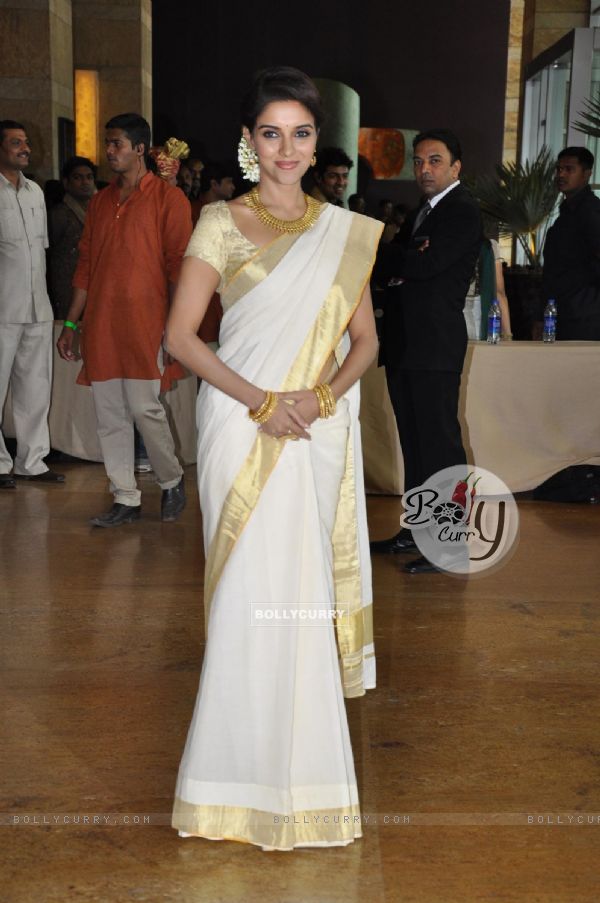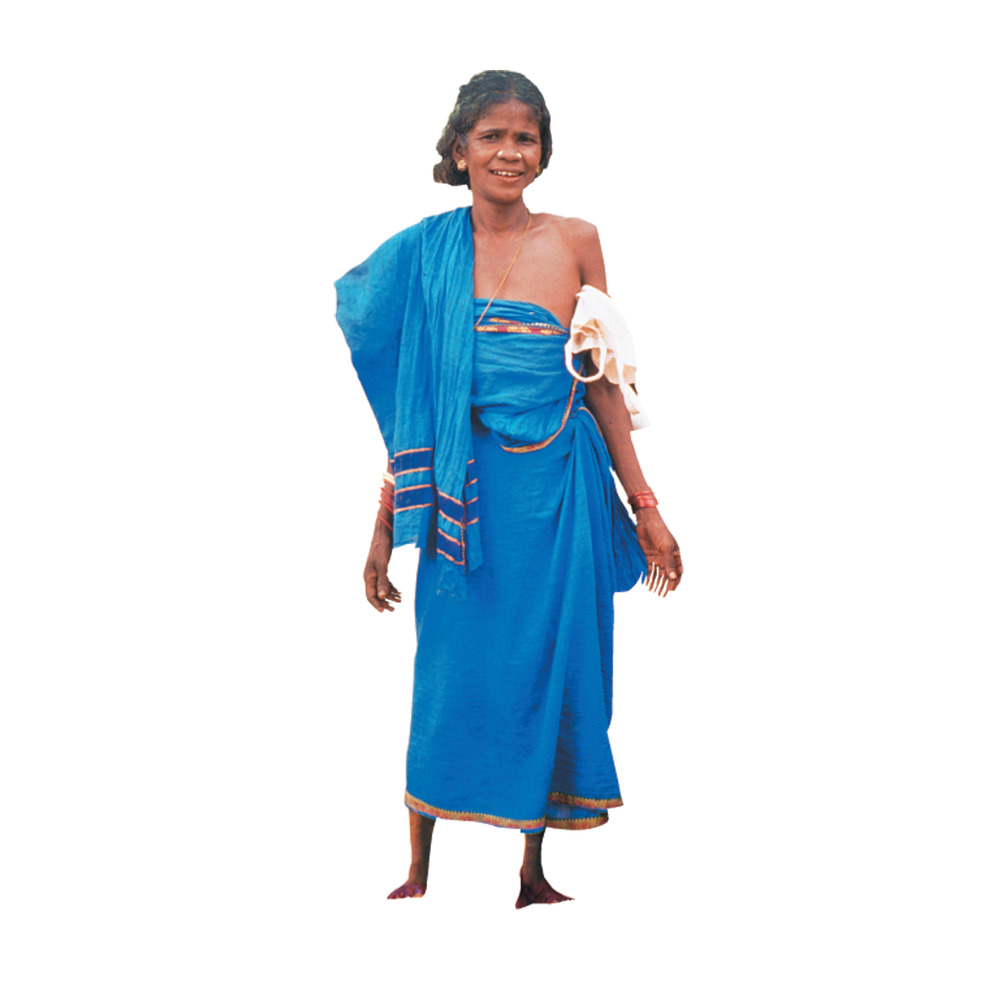The traditional sari is a thing of wonder. It showcases the skills of handloom workers -- its weave and fabric indicating its geographic region. There is no such thing as the Indian sari: it is a collection of beautiful fabrics and textiles across different Indian states, each of which have their unique way of draping the six yard.
"In the North-East, Assam is a major sari-producing centre. But the Assamese sari, though it's called a sari, is actually a two-piece garment," said Shilpa Sharma, co-founder of jaypore.com, a website that features artisanal craftswork all across India, and specialises in saris. "Punjab and Haryana don't have much of a sari-wearing history (their staple outfit is kurta with a salwar and dupatta, and a top with a long skirt respectively), but the former state has now started producing phulkari saris," she added, also revealing that Kashmir has now started reviving pashmina saris.
HuffPost India caught up with Sharma and textile scholar Rta Kapur Chishti, author of ‘Saris Of India’ who has explored the ways people wear their saris across India. "Saris were traditionally worn without pins, blouses, and even petticoats," she said, adding that local women would also wear two saris together instead of one so their work wouldn't be hindered (they could take long strides and squat comfortably). Of the many styles that dot the country, she disclosed 14 traditional ways of tying a sari that she uncovered, which can be interpreted in a modern way by any any woman as the ultimate style statement.
Karnataka Bhootheyara
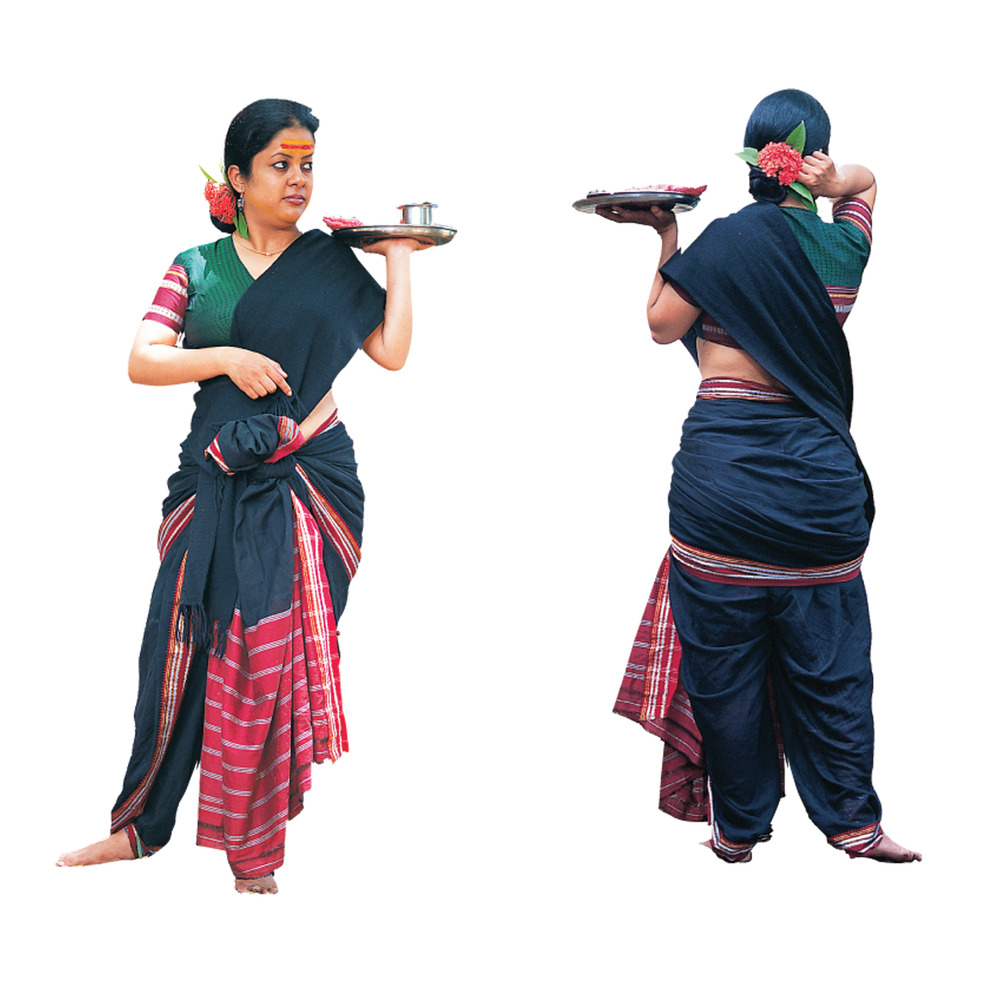
'Saris: Tradition and Beyond' by Rta Kapur Chishti
Worn by: Nomadic ceremonial performer Area: Bidar and Gulbarga district Length: 8 yd/ 7.36 m How to drape: Divide sari into half and take around waist. Knot tightly at centre front waist. Take both loose end between the legs front to back, and tuck in at centre back at least 10-12 inch. Bring both loose ends back to front. Hold both ends with either hand. Knot them together at centre of front waist. Bring left loose end around waist anti-clockwise. Tie knot at right waist with both ends. Separate drape may be taken over left shoulder and tucked in at right waist.
Goa Dhangad
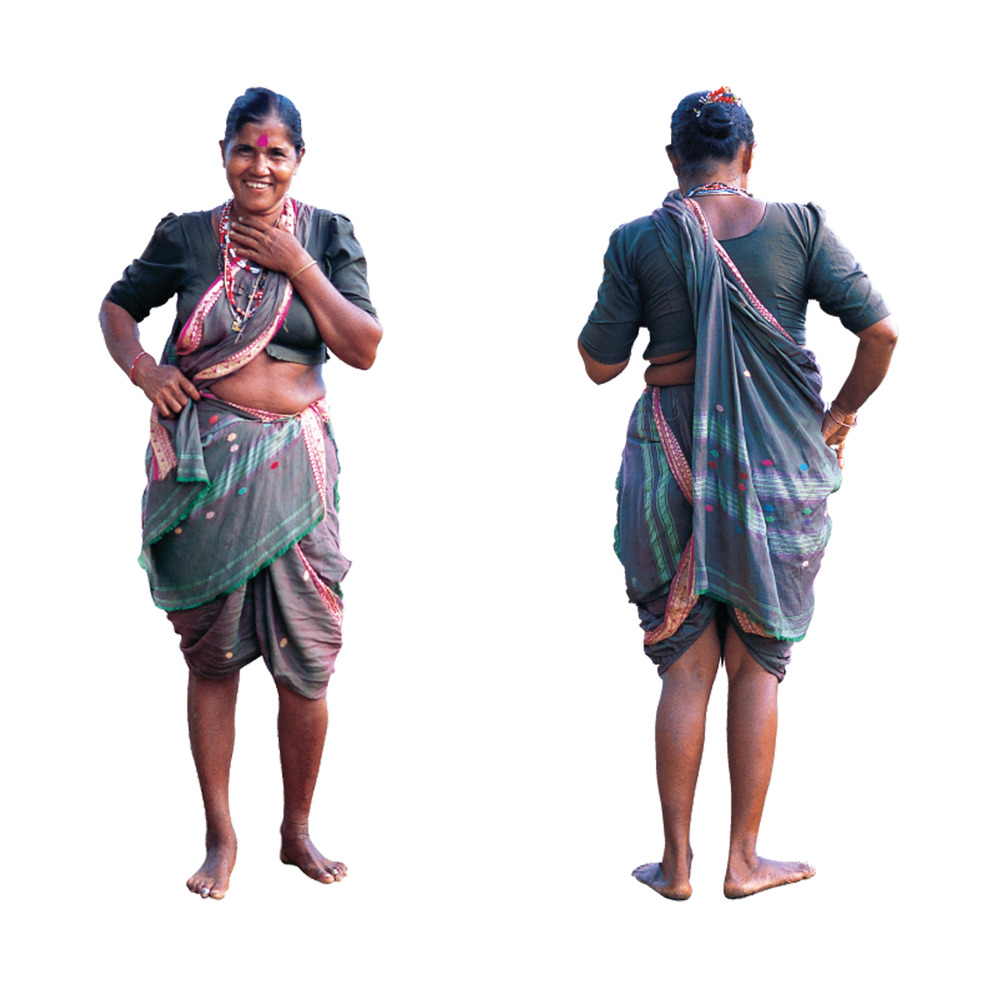
'Saris: Tradition and Beyond' by Rta Kapur Chishti
Worn by: Shepherd Community Area: North Goa Length: 9 yd/ 8.30 m How to drape: Take inner end-piece and double-fold it to arm’s length. Wrap double-folded piece around waist clockwise. Tie at right of waist. Take outer end-piece over left shoulder up to thigh length. Hold loose portion of sari in front. Make a single fold. Pleat folded portion from left to right. Continue pleating. Hold gathered pleats in front and tuck into centre waist. Lift pleats with right hand and hold loose end in left hand. Similarly, right pleats with left hand and pick up loose end over right leg. Hold them with both hands. Tuck into centre front waist. Collect centre pleats with both hands. Bring gathered pleats to back between legs. Tuck into centre back at least 10-12 inches, spreading borders o either side to form a perfect ‘v’ shape. Lift outer end-piece from back. Throw over left shoulder. Bring outer end-piece around waist anticlockwise to tuck in at left waist.
Gujarat Parsi
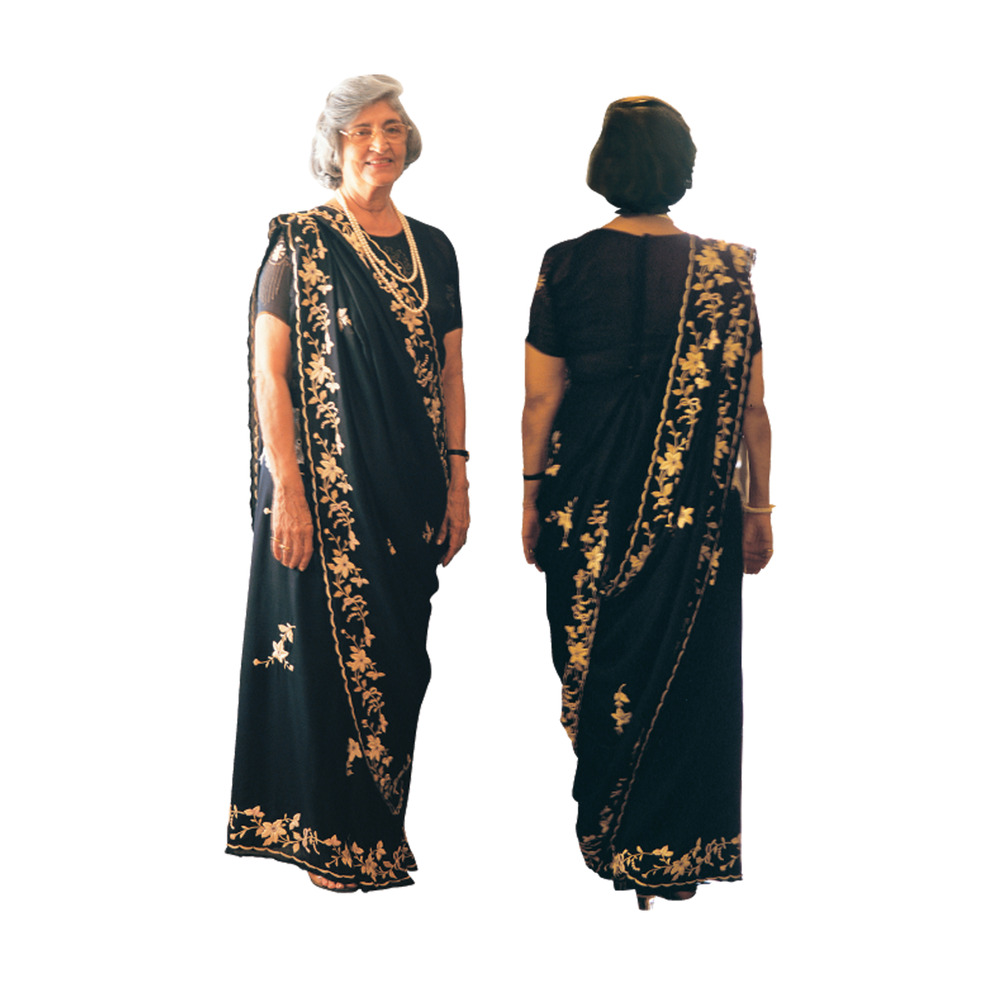
'Saris: Tradition and Beyond' by Rta Kapur Chishti
Worn by: Urban mercantile community Area: Saurashtra, Gujarat Length: 5.7 yd/ 5.30 m How to drape: Take inner end of sari, wrap it around waist anticlockwise, and tuck into petticoat at right waist. Bring outer end-piece around waist anticlockwise and hold with right hand. Throw outer inner-piece over right shoulder from back leaving right end forming a ‘v’ below knee. Make pleats of remaining loose portion of sari. Tuck into centre front waist leaving some portions free at left waist. Hold outer end-piece in place with brooch on right shoulder.
Madhya Pradesh Balaghat
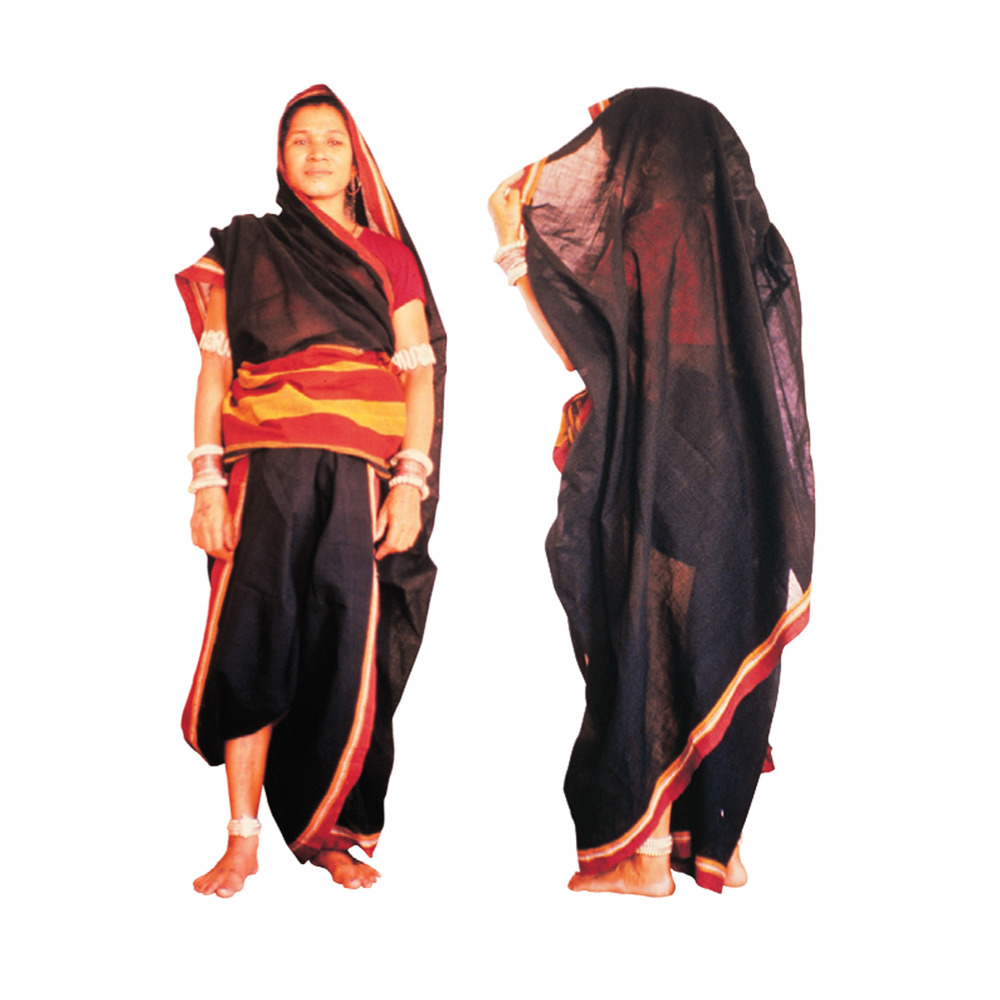
'Saris: Tradition and Beyond' by Rta Kapur Chishti
Worn by: Mara community Area: South Madhya Pradesh Length: 9 yd/ 8.36 m How to drape: Take inner end-piece and fold over into triangle at waist. Take free ends of triangle at either side of waist. Tie knot over triangle at centre front waist. Bring outer end-piece over head left to right. Tuck left corner of outer end-piece at left back waist. Make pleats from right to left. Leaving two to three pleats free in left, tuck gathered pleats at centre front waist. Pick up centre point of loose pleats. Take it back between legs. Spread borders on right side of hip and tuck in. Gathered both draped border ends from back lower-end. Catch firmly and bring to front. Bring lower borders under front pleats. Fold over front pleats in triangle. Pick up front lower border. Tuck in at left and right waist, preferably one leg more visible than the other.
Central Chhattisgarh Style
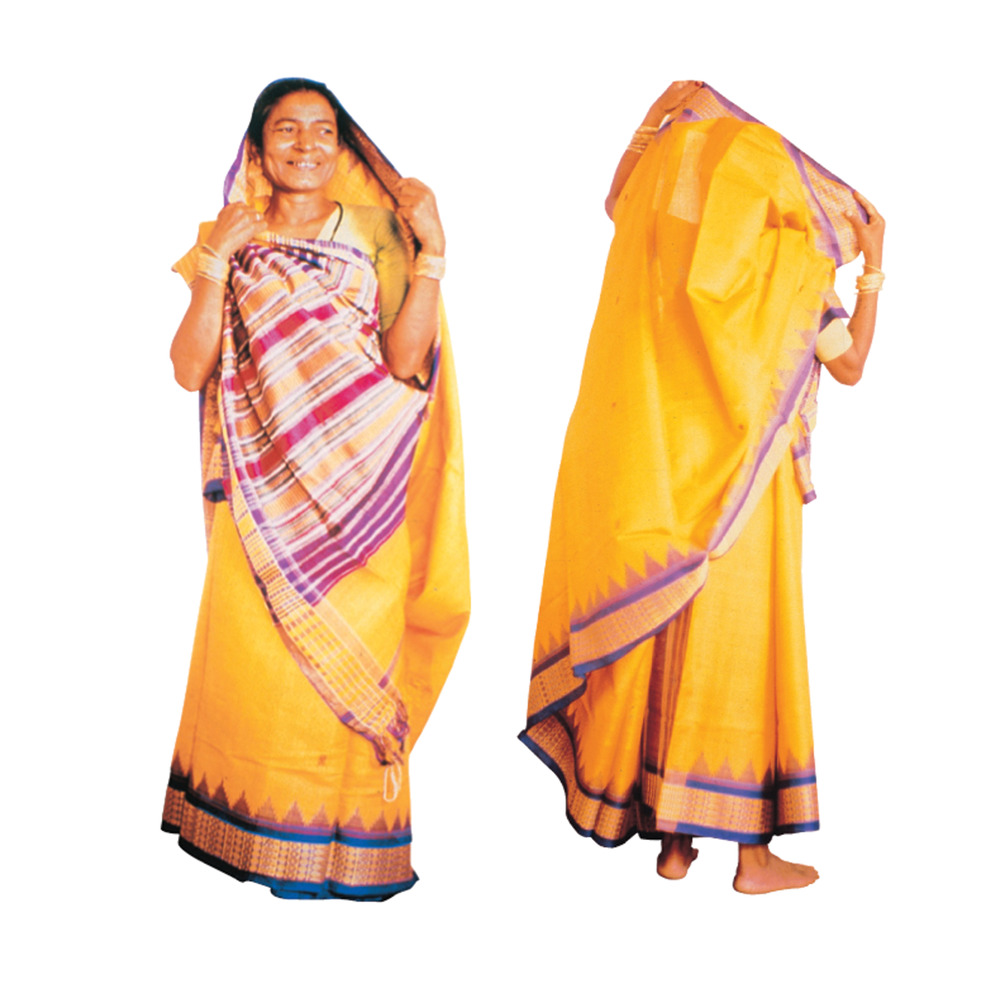
'Saris: Tradition and Beyond' by Rta Kapur Chishti
Worn by: Entire community Area: Central Chhattisgarh Length: 7 yd/ 6.5 m How to drape: Wrap inner end-piece around waist clockwise and tie/tuck in at right waist. Tuck in free end-piece at left waist and fold in front in ‘v’ shape. Bring left side of folded ‘v’ to back waist and tuck in. Bring free end-piece over left shoulder to right shoulder and drape in front. Pull left corner of outer end-piece to left waist. Bring left pulled corner around waist anticlockwise. Tuck pulled portion into front left waist.
Uttar Pradesh Seedha Pallu
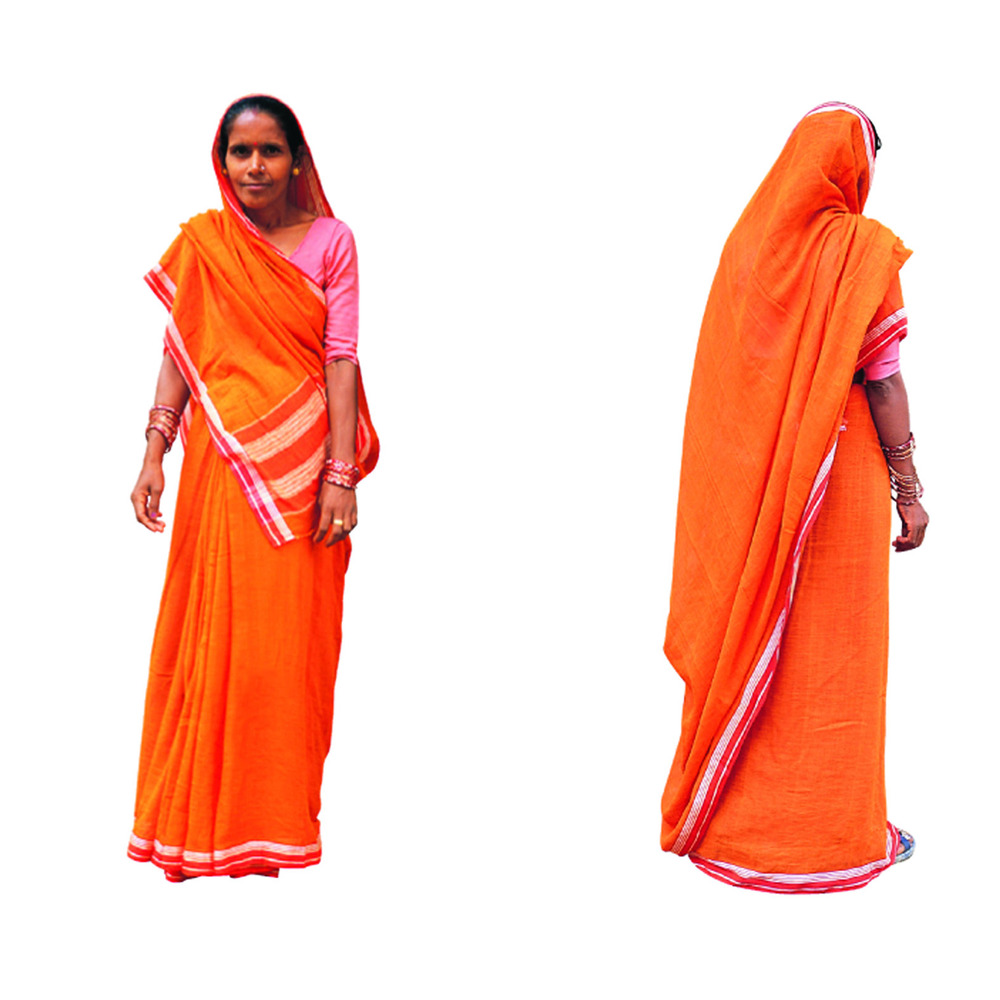
'Saris: Tradition and Beyond' by Rta Kapur Chishti
Worn by: Middle class, Urban and Rural Area: Central and Eastern U.P. Length: 5.8 yd/ 5.3 m How to drape:Wrap inner end-piece around waist and tie knot at right waist. Bring outer end-piece over right shoulder till thigh-length back to front anticlockwise, and make pleats of remaining sari. Tuck the gathered pleats in at centre front waist.
Bihar Purnia
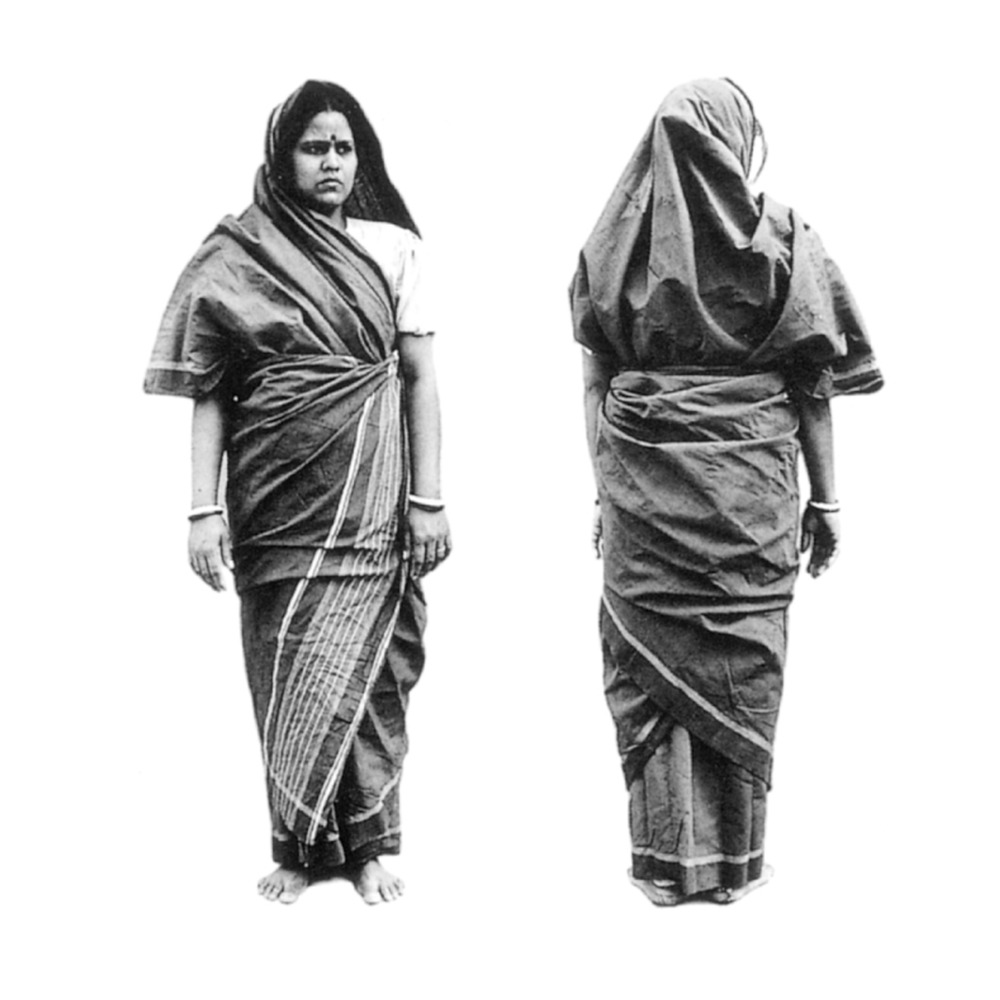
'Saris: Tradition and Beyond' by Rta Kapur Chishti
Worn by: Rural community Area: Northeast Bihar Length: 5 yd/ 4.55 m How to drape: Wrap inner end-piece around waist anticlockwise and tie/tuck in at left waist. Bring free end-piece to right waist and tuck in. Bring outer end-piece under left arm, over head, and across right shoulder back to front. Bring outer end-piece around waist anticlockwise. Tuck in outer end-piece at front left waist.
Jharkhand Santhal Pargana
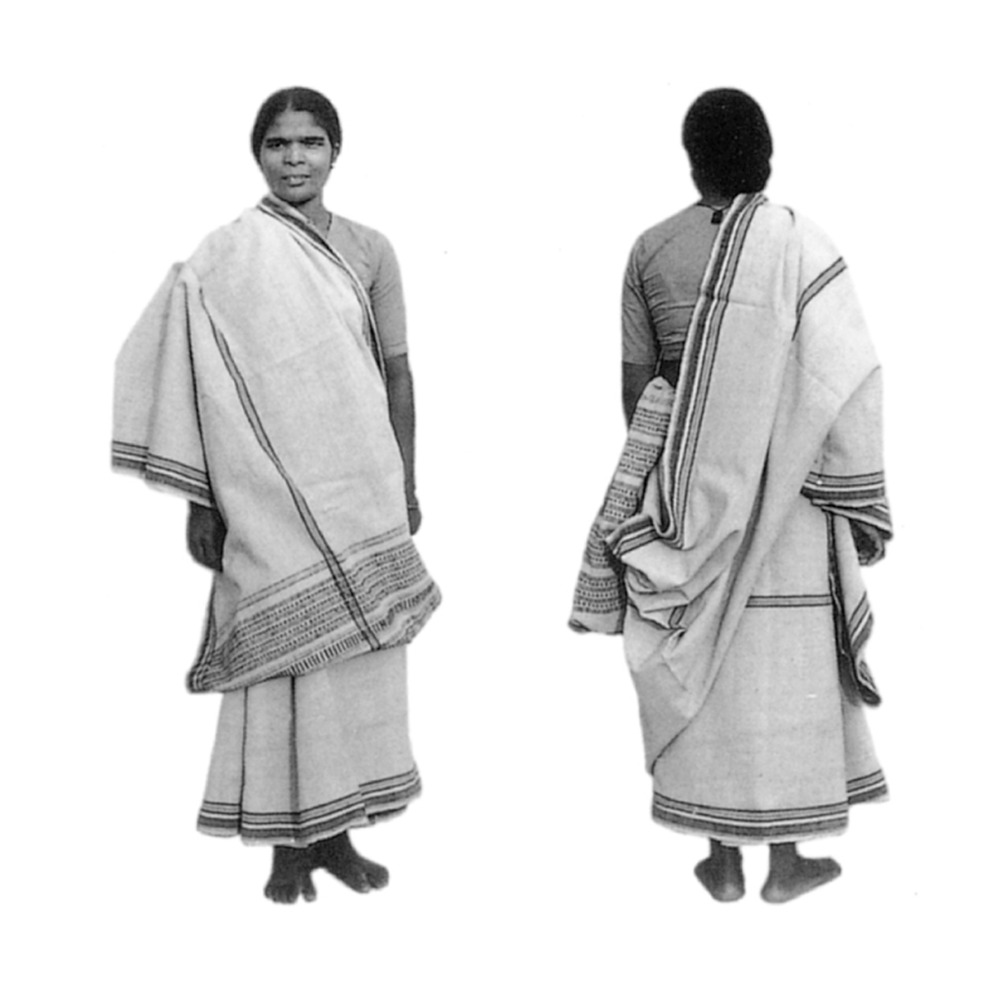
'Saris: Tradition and Beyond' by Rta Kapur Chishti
Worn by: Majhi, kurmi and other tribes Area: Northeast Jharkhand Length: 5 yd/ 4.6 m How to drape: Wrap inner end-piece around waist clockwise. Tie knot at right waist and bring free end to left and tuck in. Bring outer end-piece, over right shoulder from back to front anticlockwise. Bring both edges of outer end-piece to centre back waist from either side and tuck in.
West Bengal Nadia
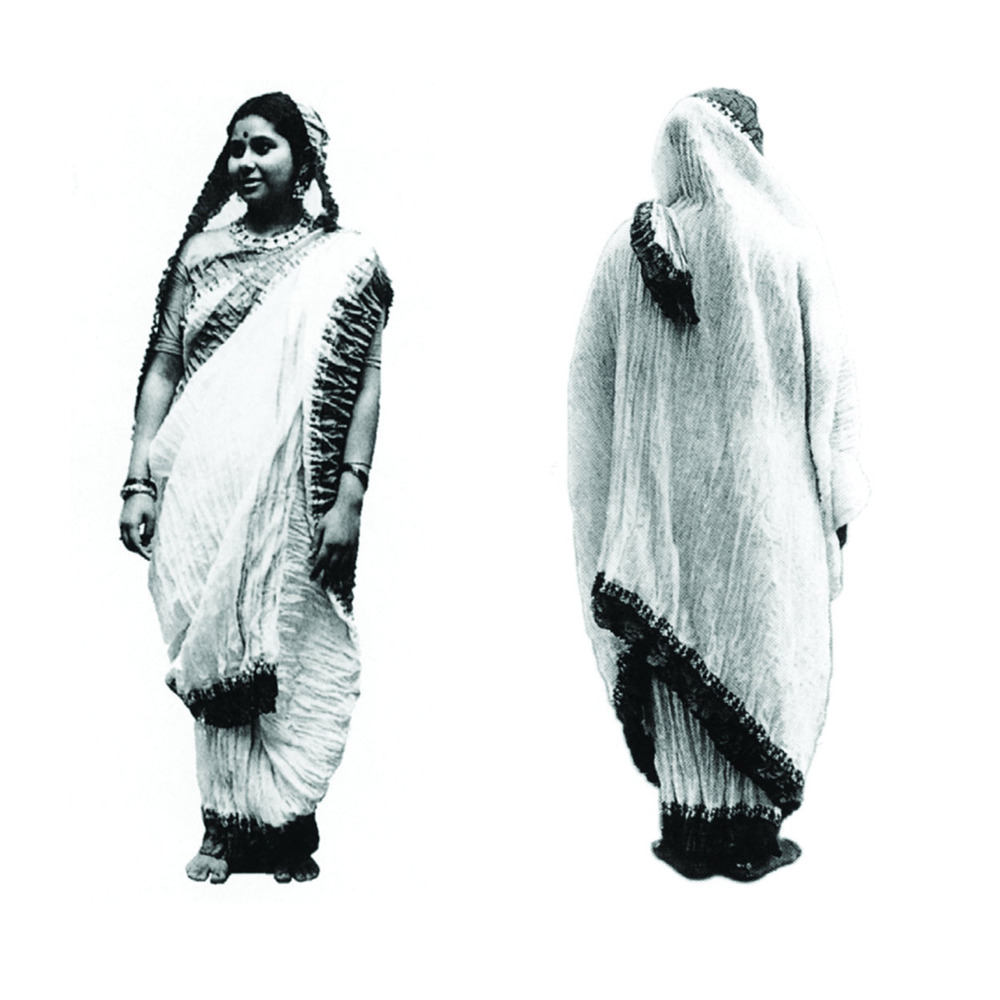
'Saris: Tradition and Beyond' by Rta Kapur Chishti
Worn by: Women during special occasions -- marriages and pujas (the more modern form of sari styling has replaced this in recent years). Area: Central region of West Bengal Length: 5.7 yd/ 5.3 m How to drape: Bring inner end-piece around waist clockwise and tie knot at right waist. Bring free end-piece to left waist and tuck in. Bring free end-piece to right waist and tuck in. Throw free end of sari over right shoulder. Adjust free end-piece over head and bring to front waist under right arm. Throw over left shoulder again.
Orissa Kotapad

'Saris: Tradition and Beyond' by Rta Kapur Chishti
Worn by: Tribal rural community Area: South Orissa Length: 5.7 yd/ 5.3 m How to drape: Wrap inner end of sari around waist clockwise and tie knot at right waist. Hold free end portion with left hand. Throw free end over left shoulder. Bring free end to front under right arm. Take outer end-piece around chest anticlockwise and tie knot with front upper border at right shoulder.
Andhra Pradesh Boggili Posi

'Saris: Tradition and Beyond' by Rta Kapur Chishti
Worn by: Golla (shepherd community); Gudati Kapulu (agriculturist) Area: Narasannapalle, Cuddapah district, Rayalseema region, South Andhra Pradesh Length: 9 yd/ 8.26 m How to drape: Bring inner end-piece around waist clockwise and tie knot at front. Bring outer end-piece around waist anticlockwise and throw over right shoulder till thigh-length. Make pleats of remaining loose portion facing right. Roll pleats outward and secure by wrapping over with innermost layer. Pick up lower borders at two extremes. Pick up lower borders at two extremes. Bring to centre back waist from either sides and tuck in.
Tamil Nadi Madisaru
'Saris: Tradition and Beyond' by Rta Kapur Chishti
Worn by: Iyengar Brahmin Area: Central Tamil Nadu Length: 9 yd/ 8.3 m How to drape: Wrap inner end of sari around waist clockwise and tie knot at right waist. Lift lower border of inner end-piece and tuck in at left waist. Make five to six pleats from right free end of sari. Spread out pleats across front and tuck in. Bring free end of sari around waist anticlockwise under right arm. Gather two to three diagonal pleats from free end of sari and tuck into left waist. Take free end of sari front to back between legs. Tuck in at centre back waist up to 12 inches. Bring free end of sari around waist anticlockwise and throw over left shoulder.
Maharashtra Nau Vari
'Saris: Tradition and Beyond' by Rta Kapur Chishti
Worn by: Popularly by Lavani performers, but also by other women Area: Central Maharashtra Length: 9 yd/ 8.30 m How to drape: Take inner end of sari clockwise around waist and tie knot at right waist. Holder outer end-piece and bring towards right side from back. Bring outer end-piece over left shoulder, overhead till knee length and make pleats of remaining free portion. Reverse pleats from left to right and take out inner two to three pleats. Wrap freed pleats around gathered pleats to bind them and tuck in at left waist. Roll pleats outward to desired length of sari into banana like form. Pull inner most layer of sari and turn outward over banana form, securing it firmly. Take lower border of back drape to center front waist. Bring it over banana-like form to reverse. Pick up centre point of left front pleats. Rollover and hold towards centre between legs. Pick up lower hemline with both hands. Bring them together to centre front. Hold both borders with left hand and stretch out to centre point. Pull centre point to back between legs. Tuck into centre back waist at least 9-12 inches and both border fall parallel at the back. Take loose end of lower border at back of legs. Wrap it inward to form a tight drape around leg up to calf. Wrapping must go completely around leg from outer to inner side. Tie cord holding ‘v’ formation of border above heel. Lavani performers usually wear at least ten rows of ankle bells over cord.
Kerala Festival style
Kerala Tribal Style
'Saris: Tradition and Beyond' by Rta Kapur Chishti
Worn by: Tribal community Area: North East Kerala, especially Wayanad and Palakad Length of upper drape: 3yd/ 2.6m Lower drape: 4.5 yd/ 4 m How to drape: Wrap inner end-piece around waist clockwise and tie knot at centre. Bring free end piece around waist anticlockwise to right front waist, leaving loose portion to left waist. Bring free end-piece across breast right to left and wrap it twice. Bring free end-piece over right shoulder back to front.
10/25/2015 | |
Permalink
 'Saris: Tradition and Beyond' by Rta Kapur Chishti
'Saris: Tradition and Beyond' by Rta Kapur Chishti 'Saris: Tradition and Beyond' by Rta Kapur Chishti
'Saris: Tradition and Beyond' by Rta Kapur Chishti 'Saris: Tradition and Beyond' by Rta Kapur Chishti
'Saris: Tradition and Beyond' by Rta Kapur Chishti 'Saris: Tradition and Beyond' by Rta Kapur Chishti
'Saris: Tradition and Beyond' by Rta Kapur Chishti 'Saris: Tradition and Beyond' by Rta Kapur Chishti
'Saris: Tradition and Beyond' by Rta Kapur Chishti 'Saris: Tradition and Beyond' by Rta Kapur Chishti
'Saris: Tradition and Beyond' by Rta Kapur Chishti 'Saris: Tradition and Beyond' by Rta Kapur Chishti
'Saris: Tradition and Beyond' by Rta Kapur Chishti 'Saris: Tradition and Beyond' by Rta Kapur Chishti
'Saris: Tradition and Beyond' by Rta Kapur Chishti 'Saris: Tradition and Beyond' by Rta Kapur Chishti
'Saris: Tradition and Beyond' by Rta Kapur Chishti 'Saris: Tradition and Beyond' by Rta Kapur Chishti
'Saris: Tradition and Beyond' by Rta Kapur Chishti 'Saris: Tradition and Beyond' by Rta Kapur Chishti
'Saris: Tradition and Beyond' by Rta Kapur Chishti
